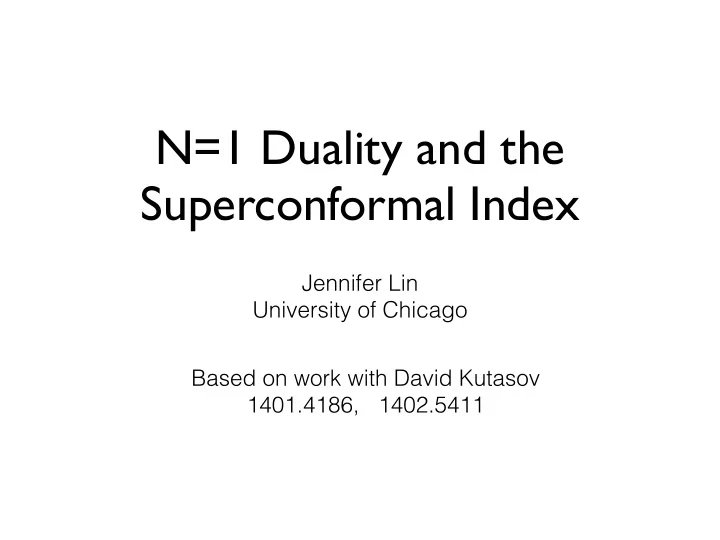

N=1 Duality and the Superconformal Index Jennifer Lin University of Chicago Based on work with David Kutasov 1401.4186, 1402.5411
N=1 Duality • 4d N=1 SQCD, a theory with gauge group SU ( N c ) Q, ˜ and flavors in the (anti)fundamental of the Q N f gauge group, exhibits Seiberg duality where in a range of , it is equivalent in the IR to a x = N c /N f different theory (magnetic SQCD).
• One can generalize SQCD by adding adjoint matter fields to the theory, and superpotentials for them. • The set of nontrivial SCFT’s that can be obtained as RG fixed points of SQCD with arbitrary amounts of adjoint and fundamental matter, correspond to adjoint superpotentials coinciding with Arnold’s ADE classification of singularities. [Intriligator, Wecht] • The , and theories in the classification A k D k +2 E 7 exhibit Seiberg-like dualities. [Kutasov, Schwimmer; Brodie; Kutasov, JL]
• For each aforementioned example, the magnetic theory contains gauge singlet mesons, that map to composite operators in the electric theory. • Using the superconformal index, one can read off the number of and spectrum of the mesons.
Superconformal Index • The N=1 superconformal index counts the short multiplets in the R × S 3 theory. It is a Witten index for the SCFT on regulated by introducing fugacities for global symmetries. [Romelsberger; Kinney, Maldacena, Minwalla, Raju] • Doing so for a certain choice of generators leads to the prescription I ( t, x ) = Tr( − 1) F x 2 J 3 t R +2 ¯ J 3 + H e − β H � • where for one of the supercharges , , is the Q † H = { ¯ Q + , ¯ ¯ + } R Q + generator of the superconformal , and are the J 3 , ¯ U (1) R J 3 Cartan generators of the of the isometry group SU (2) × SU (2) S 3 of the .
• The index is invariant along RG flow. This is R × S 3 because, thinking of it as a partition function on r Λ . it is independent of the parameter • So for theories with IR duality, the indices computed in the electric and magnetic descriptions must agree.
• The exact indices are often difficult to compute. • However in the Veneziano limit, the indices of SU ( N ) gauge theories takes on an especially simple form [Dolan, Osborn] ◆! ∞ ∞ ✓ g ( t n )¯ 1 g ( t n ) 1 X Y � I ( t ) = exp 1 − f ( t n ) − f ( t n ) + h ( t n ) n 1 − f ( t n ) n =1 n =1 • where here parametrizes all fugacities for global t symmetries, and are functions that f ( t ) , g ( t ) , h ( t ) parametrize the field content in the adjoint representation of the gauge group, in the fundamental, and gauge singlets respectively.
Finding the meson spectrum • We assume that the dual theory in each aforementioned case has the same qualitative structure as magnetic SQCD, but without specifying the meson spectrum: SU ( ˜ • Gauge group , for some integer N c ) = SU ( α N f − N c ) α • Fundamental and adjoint matter like the electric theory: N f X, ˆ ˆ q, ˜ flavors and adjoints Y q • singlet bifundamental mesons, that are mapped to α composite objects in the electric theory (where agreement between the number of mesons and the factor in the gauge group is required to match the ’t Hooft anomaly)
• Setting the large N indices of the electric and putative magnetic duals equal in each known case, yields a polynomial constraining the R-charges of the mesons. For example, for E7 one finds 2( α − 1) 2 4 � α 9 + t 9 + · · · + t 1 + t 9 t r j = X 9 . 2 2 8 10 14 16 9 + t 9 + t 1 + t 9 − t 3 − t 9 − t j =1 � • The on the LHS are the R-charges of the r j α mesons. The equation has a solution iff the roots of the denominator are contained within those of the numerator. This is the case precisely for α = 30 .
• The method allows us to also rule out a qualitatively similar dual description for the theories corresponding to the E6 and E8 superpotentials in the ADE classifications. • This is because the analogous polynomials, e.g. α − 1 1 2 3 + t 3 + · · · + t 1 + t 3 t r j = X 1 1 5 7 4 5 6 + t 3 + t 1 + t 3 − t 2 − t 6 − t 3 j r 0 for E6, have no solutions with positive for finite j s α .
Thank you!
Recommend
More recommend